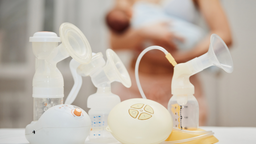Written by Tanya, IBCLC
Over the years, Tanya, a lactation consultant, has heard quite a few ‘tips’ about breastfeeding, some more beneficial than others! Here are 10 misconceptions about breastfeeding—have you received similar advice?
1. You should toughen up your nipples before breastfeeding.
This myth, like it's cousin “wash your breasts before each feeding,” has no basis in fact. There is no need to toughen up your nipples or wash them. If you're experiencing pain with breastfeeding it's not because your nipples weren't “prepared.” It's most likely due to problems with latch and positioning. So, as soon as possible, see a breastfeeding support person, like a lactation consultant (IBCLC), a La Leche League leader, a Breastfeeding USA counselor, or your local WIC office breastfeeding peer counselor.
2. Nurse 10 minutes per side.
Babies don't wear wristwatches, and they don't follow a prescribed schedule for length of nursing on each side. So substitute this bad advice with “watch the baby, not the clock.” Your baby will tell you when she is finished on one side, either by falling asleep, pulling off, or slowing down her swallowing. You can then try the other side to see if she is still hungry. Limiting feeding to ten minutes per side can also give your body the impression that less milk is needed, and might lower your milk supply.
3. You can tell how much milk you're making by pumping.
Anyone who thinks that a pumping is the same as nursing has never used a breast pump. Mothers respond differently to machines than their own, warm, babies. Some mothers pump plenty of milk. Some, who have an ample supply, pump next to nothing. So pumping output is not a reliable way to assess milk production.
4. You should wait until your breasts are “full” before feeding.
Breastmilk supply is determined by the amount of milk removed from the breast. The more milk removed, the more milk you will produce. So waiting until your breasts are “full” will have the effect of reducing your milk supply over time, resulting in your baby receiving less milk. It also puts you at risk of engorgement, which is painful and can lead to milk congestion and even breast infections.
5. Small breasts = less milk.
Tell this to the moms with small breasts who have too much milk! Or the moms with larger breasts who struggle with milk supply! Breast size doesn't have anything to do with the presence of the milk making structures (ducts, alveoli) in the breast, which don't take up a lot of space.
6. If you have mastitis you should stop nursing on the infected side.
Breast infections are usually the result of congestion of milk in the breast. So helping that congestion clear is part of the process of resolving the infection. “Resting your breast,” as is sometimes recommended, will also make a painful situation even worse, by creating engorgement. Some women find pumping to be less painful than nursing, but either way, continuing to remove milk from the infected breast is important. If you have a breast infection, be sure to see your health care provider, as well as a breastfeeding support person, like a lactation consultant (IBCLC), a La Leche League leader, a Breastfeeding USA counselor, or your local WIC office breastfeeding peer counselor.
7. Breastfed babies need extra water in hot weather.
Breast milk provides plenty of water to babies and, as long as they are allowed to nurse without restriction, babies to not require additional water, even in very hot climates. As Kellymom states, “A number of research studies investigating the need for water in exclusively breastfed babies were done in various locations (both humid and dry) at temperatures ranging from 22-41°C (71.6-105.8°F) and 9-96% relative humidity; these studies concluded that exclusive breastfeeding provides all the fluids needed.”
8. If you have to take an antidepressant you will have to wean.
For a mother who requires a medication to treat her depression, this advice isn't only wrong - it's dangerous. It forces her to choose between weaning and leaving her depression untreated, which can be dangerous for her and for her baby. Fortunately, there are medications which are considered safe. If you are receiving this advice from your health care provider, you may wish to seek more information from the Infant Risk Center, which provides information about the use of antidepressants and nearly all other medications while breastfeeding.
9. After one year, breast milk has little nutritional or immunologic value.
The composition of breast milk is the result of evolution, and is designed to meet the nutritional and immunologic needs of babies at different ages. After six months, or one year, it remains highly nutritious and continues to provide immune protection to your baby. In fact, some immune factors actually increase as the baby gets older.
10. After a contrast scan (or after general anesthesia), you have to pump and dump.
Radiocontrast dyes used in some scans do not require pumping and dumping (not to be confused with radioisotopes which do require precautions). Pumping and dumping is not required after general anesthesia either. When you are alert enough to breastfeed your baby, the amount of medication in your blood is so low that it would not be significant levels in your milk.
We hope that breaking down these breastfeeding myths is helpful—let us know if you have heard any others!
Information in this post is provided for educational purposes only, and is not intended as medical advice. For medical care related to any of these issues, see your healthcare provider.



